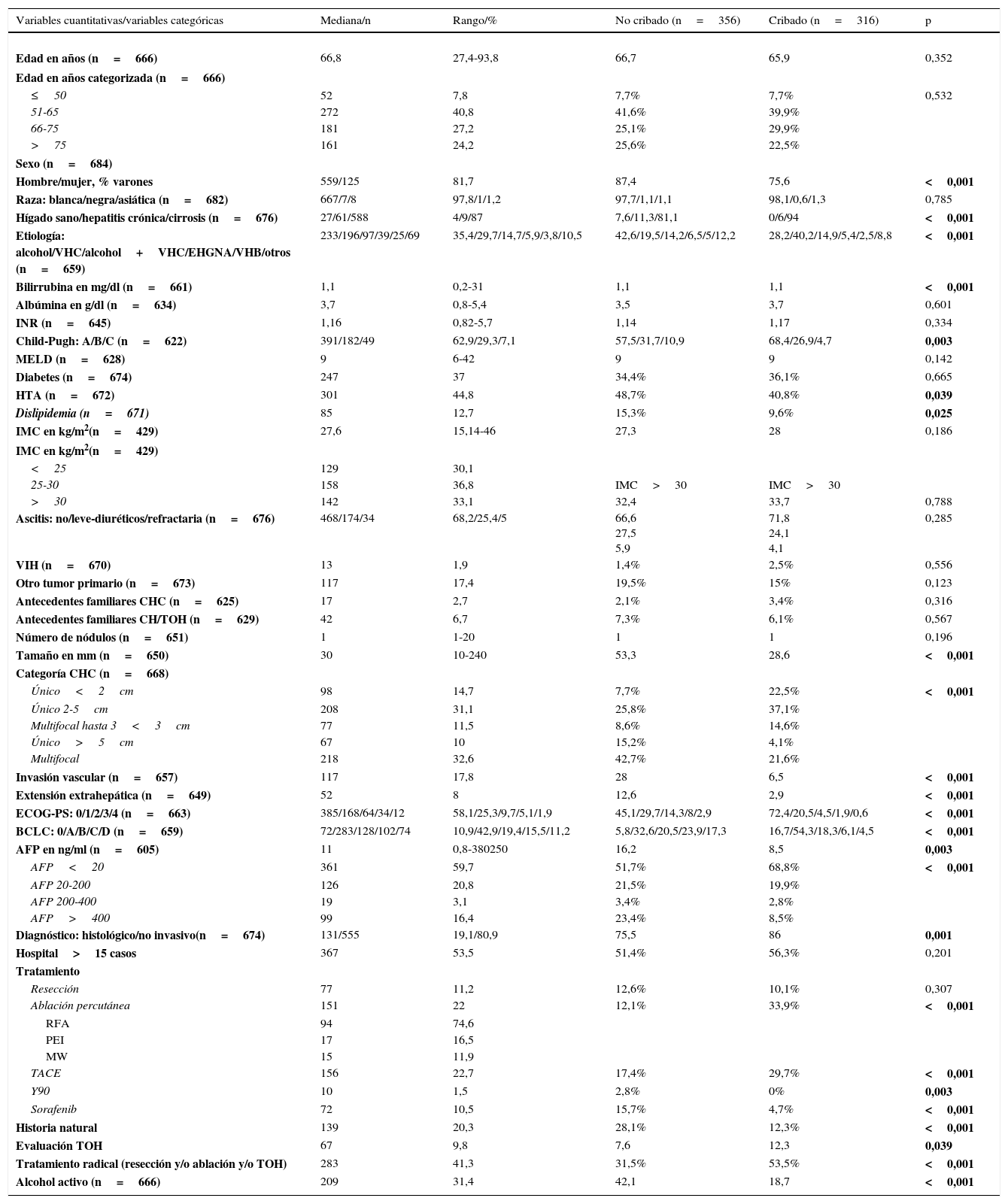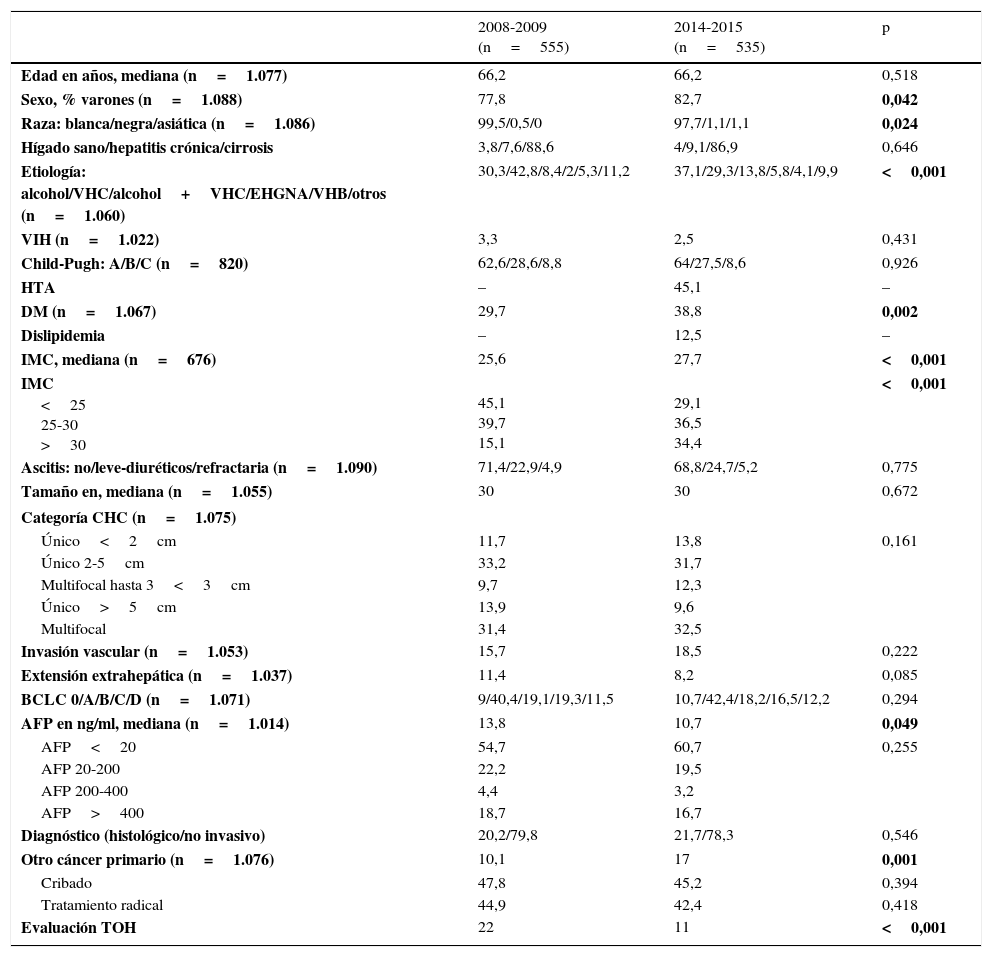En 2010 publicamos que en España el 53% de los carcinomas hepatocelulares (CHC) se diagnostican fuera de programas de cribado, lo que conlleva una menor supervivencia. El objetivo del presente estudio es evaluar la situación actual y las causas del diagnóstico fuera de cribado.
Material y métodosRegistro prospectivo entre el 1 de octubre de 2014 y el 31 de enero de 2015 en 73 centros asistenciales españoles de segundo/tercer nivel. Se registraron las características basales y el primer tratamiento de los tumores primarios hepáticos incidentales de ese período.
ResultadosSe incluyeron 720 pacientes: CHC (n=686), colangiocarcinoma intrahepático (n=29), hepatocolangiocarcinoma (n=2), otros (n=3). Los pacientes con CHC fueron varones en el 82% de los casos; media de 67 años; cirrosis en el 87%; etiología: alcohol 35%, VHC 30%, alcohol y VHC 15%, enfermedad hepática por depósito de grasa 6%; estadio tumoral: BCLC-0 11%, A 43%, B 19%, C 16% y D 11%; tratamiento inicial: quimioembolización transarterial (23%), ablación percutánea (22%), tratamiento sintomático (20%), resección (11%), sorafenib (11%). Se diagnosticaron fuera de cribado 356 pacientes (53%). Los motivos principales fueron la ausencia de diagnóstico previo de hepatopatía (76%) y la mala adherencia al cribado (18%). Estos pacientes eran predominantemente varones (p<0,001), de etiología alcohólica (p<0,001), con consumo activo de alcohol (p<0,001) y se diagnosticaron en estadios más avanzados (p<0,001), recibiendo menos tratamientos radicales (p<0,001).
ConclusionesEn España, la principal causa del diagnóstico de CHC fuera del cribado es la ausencia de diagnóstico previo de enfermedad hepática, principalmente en varones con consumo de alcohol. La detección de hepatopatía en población asintomática y la mejora de la adherencia al cribado son los principales aspectos para mejorar la detección precoz.
In 2010 we published that 53% of cases of hepatocellular carcinoma (HCC) detected in Spain were diagnosed outside the context of standard screening programs, which consequently leads to lower survival rates. The aim of this study was to analyze the current situation and the causes of diagnosis out of screening programs.
Material and methodsProspective registry of 73 second- and third-level Spanish healthcare centers carried out between October 1, 2014 and January 31, 2015. The baseline characteristics of the disease and the first treatment administered for the incidental primary liver tumors during such period were recorded.
ResultsA total of 720 patients were included in the study: HCC (n=686), intrahepatic cholangiocarcinoma (n=29), hepatic cholangiocarcinoma (n=2), other (n=3). HCC characteristics: male 82%; mean age 67 years; cirrhosis 87%; main etiologies: alcohol 35%, HCV 30%, alcohol and HCV 15%, non-alcoholic fatty liver disease 6%; tumor stage: BCLC-0 11%, A 43%, B 19%, C 16% and D 11%; first treatment: transarterial chemoembolization (23%), percutaneous ablation (22%), symptomatic treatment (20%), resection (11%), sorafenib (11%). Three hundred and fifty-six patients (53%) were diagnosed outside of screening programs, mainly owing to the fact that they suffered from an undiagnosed liver disease (76%) and to the poor adherence to the screening program (18%). These patients were mainly male (P<.001), with an alcoholic etiology (P<.001) and active alcohol consumption (P<.001). Moreover, the disease was predominantly diagnosed at more advanced stages (P<.001) and was addressed with less radical treatments (P<.001).
ConclusionsIn Spain, the main cause of diagnosis of a HCC outside the context of a screening program is the absence of a prior diagnosis of a liver disease, particularly in alcohol-consuming men. Detecting a liver disease in asymptomatic populations and improving adherence to screening programs are the main areas that must be subject to improvement in order to improve the early detection of HCC.
Artículo
Comprando el artículo el PDF del mismo podrá ser descargado
Precio 19,34 €
Comprar ahora











